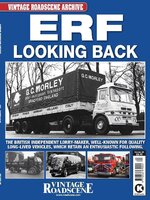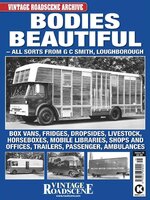Vintage Roadscene Archive is a series of one-off publications taking a comprehensive look at key aspects of road transport history from lorry manufacturers, operators and industries. These publications are featured in a largely pictorial presentation, using the resources of well-known photographic archives, backed up by the memories of enthusiasts and industry professionals who were there at the time. Vintage Roadscene Archive provides an unrivalled wealth of information and period pictures go to make up an ongoing series which will build into a library of interest to all transport enthusiasts. With each issue you can be assured of interesting and informative reading, enhanced with top-quality pictures of various aspects in road haulage.
LEYLAND – MISSION IMPOSSIBLE? • There have been dozens of books published covering the rise – and tragic fall – of Leyland. Yet even the most comprehensive still struggle to tell the whole story within 200 pages, or more. The subject matter really is that complex. Indeed, the story of Leyland might be better covered by a TV ‘Soap’. But with lorries and buses. And more human carnage, obviously. Covering it all in just 100 pages? That really is ‘Mission Impossible’. So, taking that on-board, Malcolm Bates tries to stick to some personal observations, adds a dash of historical perspective and delves into the Stevens-Stratten Archive. So let’s see what turns up…
Seventy Years of Progress
“LEYLAND - FOR ALL TIME”? SADLY, NO… • “For All Time” was the strapline featured on the famous Leyland roadside clocks and at the er, ‘time’ they were introduced, it really did look like the Leyland Brand was here to stay. The Great War ‘RAF Leyland’ was a legend. The Leyland ‘Zoo’ of model types was ever-expanding. Leyland goods and passenger chassis were increasingly successful at home and in overseas markets. And after Peace returned in 1945 even more so. So far, so good. Here, Malcolm Bates, with some welcome input from Mike ‘Leyland Man’ Sutcliffe, charts The Rise - and tragic Fall - of the Leyland Empire.
THE EARLY YEARS LEYLAND - MORE HISTORY THAN MANY COUNTRIES • Such is the tumultuous recent history of ‘British Leyland’ and the humiliation that came from it’s subsequent dismemberment and ultimate demise (Surely, we should all be ashamed of what was allowed to happen in our name?), that we tend to forget that the Leyland name goes back to 1896 and via it’s antecedents, even earlier than that. That means that this British manufacturer of lorries (and buses) has more ‘history’ than many of the Countries out there on the World stage that now claim to have the right to tell us what we should be thinking! The cheek! Utilising initially steam, then petrol - and from 1933 diesel power as well - how did it all start? Let’s take a look at some early Leylands in an effort to find out…
THE 1930s THE SPRINGBOARD TO WORLD DOMINATION? • There’s a long-standing rumour that at one stage in the 1930s, Leyland itself was the subject of a takeover bid, by Dennis Brothers of Guildford. As an illustration of how difficult it is to read ‘The Future’ of the Vehicle Industry, who would have predicted back then, that it would be Dennis that would stay independent for longer than Leyland? Or ironically, that both these British brands would end-up being owned by the Dutch? In the end, Leyland did survive the difficult trading conditions of the 1930s and managed to pioneer several chassis design concepts that would provide a springboard into World Domination in the post-war era. Which makes this period doubly important, then…
LET’S TAKE A ‘FIREBREAK’
FORMING THE ‘LINK-ZZ’?
BEAVERS, HIPPOS AND AN OCTOPUS • Immortalised, although it has to be said not very well, by Dinky Toys, as a small-scale two-axle Beaver dropsider in a boring grey paintjob and more flamboyantly (but less prototypically accurate) as that big red double...

 Volume 20
Volume 20
 Volume 19
Volume 19
 Volume 18
Volume 18